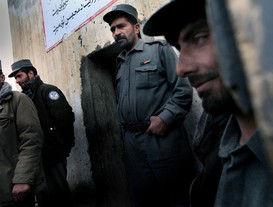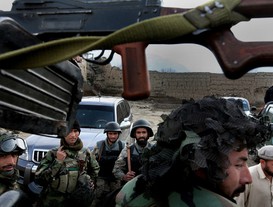Alberto Arce
2010.
Espanya,
Afghanistan.
vo Castellà,
Àrab.
s Castellà.
7’
És evident que els homes finalment detinguts, emmanillats a terra, no són més que policies joves amb barba i un mocador al cap substituint la gorra reglamentària. Ni un tret, ni una cursa. Ràpid i net. Podria presentar-se l'escena com una exclusiva periodística. Ningú més que nosaltres sabria si és cert o no. Resulta massa groller i fixat per als testimonis presencials, però amb les càmeres i l'edició es fan meravelles. Entrevista de rigor. “Moltes vegades els enemics roben o compren uniformes de policia per infiltrar-se"; És només un tràmit. La majoria dels acostaments es converteixen precisament en això, en una lluita del periodista contra la propaganda militar.
La cita, en una gasolinera. El comandant Said Mosen ha passat a recollir-nos amb una puntualitat sorprenent per a l'entorn, amb prou feines amb una hora de retard. Sense preguntar, amb la càmera com a únic visat, salto a la part posterior i descoberta d'una camioneta que ocupen sis policies gairebé adolescents. Aixeco l'armilla antibales i els l'ensenyo. Riuen. Cap d'ells no en porta. Acabarà convertida en una catifa per seure. Que almenys serveixi d'alguna cosa si trepitgem una mina. Ens dirigim a la mina d'Ainak, a la província de Logar. Un recorregut d'uns 100 quilòmetres per una carretera que serpenteja, entre roques i muntanyes, per desembocar en la que és, suposadament, la segona mina de coure més important del món. Està gairebé a punt per a ser explotada. S'imposa, no obstant això, un breu acostament previ a la Policia Nacional Afganesa. L'apropament a les forces de seguretat ha estat possible gràcies a una setmana de gestions. És fruit d'aquesta combinació indissoluble de persistència i casualitat que es converteix en l'única metodologia possible per a l'èxit del treball. Un general, veí a Kabul, del traductor que ens acompanyarà, ha parlat amb el seu germà, que està destinat a la unitat que escorta diàriament els enginyers xinesos que dirigeixen l'exploració del coure d'Ainak. Una vegada gestionat el vistiplau —telefònic— del comandant de la unitat, hem perdut tres matins a les diverses dependències del Ministeri d'Interior afganès sense cap resultat. En aquest país, no existeix la finestreta única. Al quart dia, el tabac desencalla la situació i ens mostra, al mateix temps, qui mana realment. Una cigarreta aleatòriament compartida amb un tinent d'enllaç de l'exèrcit nord-americà —un militar tan planer com executiu— acaba per convertir-se en el camí directe fins a la signatura del cap de premsa del Ministeri, requisit necessari per al viatge, el mateix que es negava a rebre'ns fins que li ho va demanar la persona adequada. Això sí, especificant que hi viatjàvem a través d'un contacte personal, a causa de la seva proximitat amb Kabul i sense cap interès en la mina dels xinesos. Quin motiu hi hauria per interessar-se per la mina? Que sigui una empresa xinesa l'encarregada de l'exploració i futura explotació de les reserves de coure del país? Naturalment que no. Cada vegada que un cotxe s'apropa, cops de botzina i una arma que apunta directament contra el vehicle sospitós. Aquí qualsevol ho és. Parada per recollir el pa. Les seques mirades del veïnat ho diuen tot. Hem entrat en zona vermella. Transitem pel centre d'una vall i, davant de la mida de les muntanyes, un minúscul exemple de les que s'endevinen més a prop de l'horitzó, és possible fer-se una petita idea de la complexitat de la lluita contra la insurgència. Els policies assenyalen directament una muntanya. “Allà hi ha els talibans.” Sembla a prop.“Pugeu a buscar-los?”, pregunto.“És clar que no”, responen. “Ningú no té permès el pas a aquesta vall. Només nosaltres i els treballadors de la mina, quan els escortem.” El capità Gul, el nostre contacte i guia, és germà del general Sarjan, veí a la vegada del nostre traductor. Es pren el viatge amb els estrangers com un entreteniment i està disposat a portar-nos a la mina. És evident que la seva actitud, tan educada amb l'estranger com disposada a complir amb el favor que el seu germà li he demanat, no concorda amb les ordres dels superiors, a qui, no obstant això, difícilment s'oposarà. Finalment, la caserna a la qual ens dirigim. Amb prou feines dos edificis en construcció. Mig centenar d'homes esperen, amb el motor encès i les armes preparades, l'arribada del comandant i dels estrangers que l'acompanyen. Está todo preparado para un breve empotramiento. El objetivo declarado de este viaje es conocer el trabajo de las fuerzas de seguridad afganas sobre el terreno. El oculto, llegar a la mina de cobre. Està tot preparat per a un breu acostament. L'objectiu declarat d'aquest viatge és conèixer la feina de les forces de seguretat afganeses sobre el terreny. L'ocult, arribar a la mina de coure. Després del te, passem a una sala per rebre instruccions respecte a l'operació. Hi ha un mapa a la paret i el comandant Said Mosen, amb un pal de fusta a la mà, comença a donar instruccions. “Ens han informat que alguns enemics -mai no utilitza el terme talibà-“poden estar amagats a la zona. Anem-ho a investigar.” Quatre suboficials l'escolten mentre desenvolupa la seva estratègia de desplegament en cadena. Un centenar d'homes s'expandiran, caminant en una línia que s'eixampla des del vessant de la muntanya fins al centre de la vall, per, posteriorment, anar estrenyent el cèrcol i envoltar i atrapar els que s'amaguen. Uns 10 vehicles emprenen el viatge. No hi ha tensió a l'ambient. Els homes posen els peus a terra a la base d'una muntanya i comencen a desplegar-se en forma de falç. “Si els enemics són on ens pensem, al lluny–mentre assenyala en direcció a cap lloc–, els envoltarem i tancarem qualsevol possibilitat d'escapada” comença a explicar el comandant Mosen. Després de caminar molt en formació, sota un sol aclaparador, muntanya amunt i muntanya avall, i tot i l'indici de dubte que sorgeix pel que fa a l'absència de tensió a les cares i als moviments dels uniformats, la ràdio informa de l'arrest de diversos insurgents. Es mobilitza un transport perquè els periodistes puguin arribar-hi i filmar-los. És evident que els homes finalment detinguts, emmanillats a terra, no són més que policies joves amb barba i un mocador al cap substituint la gorra reglamentària. Ni un tret, ni una cursa. Ràpid i net. Podria presentar-se l'escena com una exclusiva periodística. Ningú més que nosaltres sabria si és cert o no. Resulta massa groller i fixat per als testimonis presencials, però amb les càmeres i l'edició es fan meravelles. Entrevista de rigor. “Moltes vegades els enemics roben o compren uniformes de policia per infiltrar-se…” És només un tràmit. La majoria dels acostaments es converteixen precisament en això, en una lluita del periodista contra la propaganda militar.

